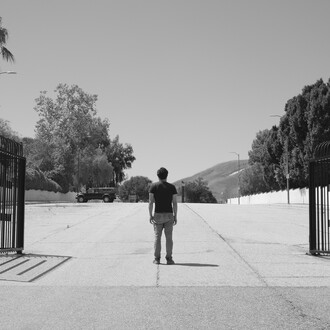For many years, three major themes have been central to the work of artist Martin Dammann: collecting photographs, exploring historical and psychological conceptions of reality, and searching for and excavating fossils.
In close cooperation with the Archive of Modern Conflict, Dammann collects photographs from estates, private individuals, and photo and military exchanges. These images, often anonymous and fragmentary, are the starting point for his artistic work. He is interested in what lies beneath the visible surface – the quiet, often overlooked stories that each image carries within it.
Dammann became particularly well known for his large-format, colour-intensive watercolours, in which he transforms selected motifs from the archive or from his own photographic collection into paintings. The selection of motifs is intuitive – always guided by the search for what Walter Benjamin called the ‘spark of reality’. At the heart of this artistic process is transformation: making hidden levels of meaning and emotional resonances visible.
With his current exhibition, Ein loch graben (Digging a hole), Martin Dammann undertakes a very personal attempt to trace the psychology of artistic inspiration and his own creative convictions. The exhibition is intended as a reflection on research, uncovering and preservation – central activities that are anchored in both collecting and artistic work. For this reason, the accompanying press text does not consist of a classic introduction, but of a diary-like text by Martin Dammann himself. In it, the artist provides insight into his thoughts, doubts and fascinations – an intimate access to the inner motivations of his artistic work.
„For many years, I have been searching for fossils of prehistoric mammals near Lusk, Wyoming, in the deepest canyons of a huge ranch. For almost as long, I have been looking for ways to translate this overwhelming experience into an exhibition. But that proved more difficult than I thought. If you paint a human skull, you have a metaphor. If you paint the skull of a prehistoric horse, you have – the skull of a prehistoric horse. It’s hard to say why that is. Perhaps it has something to do with the fact that these fossils have resisted their final disappearance for such an unimaginably long time. Or because the imagery that attracts me is already so ingrained in them that translating it into an actual image doesn’t make much difference. Whatever the reason, it took a very long time before I felt I had found an artistic approach. Finally, however, possibilities opened up for me: first through videos, then painting.
It was strange. Over the years, I have taken many thousands of photos in the canyons. And I have looked at each and every one of them again and again. But in the end, surprisingly few motifs were suitable for a watercolour painting. Then – when I was already in the middle of painting – I noticed that these ‘suitable’ motifs all somehow kept their distance from the fossils. Also from the expansion, the moments when something becomes visible. Not because there weren’t any photos of them. Or because they couldn’t be painted. But the expected images would reveal nothing of the complex process that takes place: from the discovery, the initial assessment of what might be there, through all the decisions and twists and turns, to the moment when the chunk of rock in which the fossil is embedded actually lies before you.
So the closer I got to the fossils themselves, the more difficult it became to paint them. It was as if the fossils refused to be painted, as if they repelled the paint. Like trying to press two magnets of the same polarity together. Nevertheless, the pictures seemed to make sense to me. The painting was rejected by its subject, and so it became a kind of soliloquy. About painting, about what I can communicate with images. It seemed as if the watercolours were extending their structure of omission and flow to their subject, the fossils, circling the actual event but not occupying it. What they show is more of a state than a process. The searching, not the finding. Perhaps not even that. Perhaps what manifests itself in the exhibition is only the longing to search, which often overwhelms me when I am in my studio in Berlin.“
In addition to taking photos, I filmed extensively in Lusk. The resulting videos pick up where the watercolors leave off. Das loch (video, 24:22 min, 2025) connects the search for, discovery, and excavation of a fossil with a traumatic moment in my childhood that was decisive both for my decision to pursue art and for my fascination with fossils and photography. A key experience, in other words.
(Text by Martin Dammann, Berlin, October 2025)
















